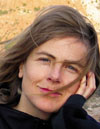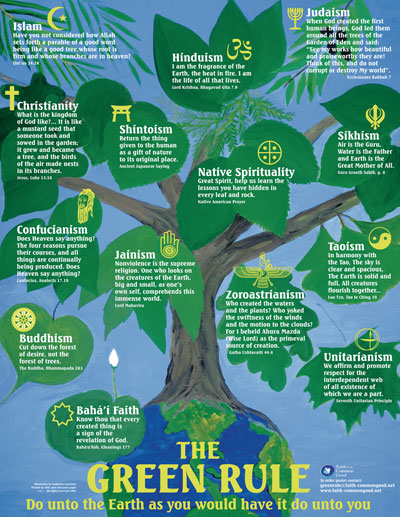The Green Rule poster
A collection of texts from the world's great religions
... all have a concern for the integrity of creation
By Katherine Vansittart
April 2006
Return to Table of Contents
Print Article

Katherine Vansittart
Much of my youth was spent immersed in nature. Every weekend and summer holiday my family retreated to our cottage northeast of Toronto where, over the years, the trees, wildflowers, birds and tadpoles became my friends. It was a silent friendship, yet one imbued with a sense of love, kindness and mystery. My childhood was often solitary, but I never felt lonely among these beings.
My relationship with nature continues to impact my life today and has led to my work with Faith & the Common Good (FCG), a national interfaith network. FCG's mandate is to bring together people of all faiths to dialogue and work together on issues of social justice and ecology. We consider the degradation of God's creation the most pressing social, political and environmental issue of our time. We also believe that this ecological crisis is, at its heart, a crisis of the human spirit, which can be healed only with the combined will of all people and wisdom from all our faith traditions.
In the autumn of 2004, I hosted Faith & the Common Good's annual three-day retreat at the same cottage where I spent so much of my youth. Attending the meeting was founder and director, Rev. Ted Reeve; Chair, Rev. Bill Phipps; web designer Mark Hathaway, along with our advisors and animators from across the country. We gathered to plan the coming year's projects.
At some point in our visioning sessions someone said, "How about a Green Rule poster?" We were all familiar with the Golden Rule poster produced by Scarboro Missions. A Green Rule poster seemed like an obvious next step. It would say, in essence, "Do unto the Earth as you would have the Earth do unto you."
The Green Rule asks us to consider who is our neighbour?
The concept seemed ideally suited to what FCG is communicating about the importance of diversity, whether it be religious, cultural or biodiversity and that everyone has a part to play in renewing the sacred balance of the planet.
The Green Rule asks us to consider who is our neighbour. Are the birds and bees our neighbour? The lakes and trees? The intention is not to worship nature and creatures but to appreciate and care for the whole of creation that sustains us.
Sacred texts
As designer/coordinator of the Green Rule poster, I looked to the same sacred texts as the Golden Rule, including the Bible, the Qur'an, the Bhagavad Gita, the Tao Te Ching, the Analects and the Guru Granth, as well as to oral traditions and prayers. I then met with faith leaders and lay persons from different faith traditions to determine the one statement from each text that best epitomizes the role of the human species as Earthly stewards and our actual oneness with the whole web of life. That each tradition has numerous such references demonstrates that all major religions and spiritual philosophies have at their core a concern for the integrity of creation.
The reasons for choosing a tree as the central image of the poster were both practical and spiritual. There is the one tree, yet that tree has many different species of leaves. Each leaf represents a different faith tradition and has some significance to the faith it represents. The banyan leaf, for example, contains the Hindu Green Rule. In India, the banyan tree represents fertility, love and life. The ancient Hindus believed the tree to be home to the holy trinity of Hindu gods (Brahma, Vishnu, Shiva).
Buddha found enlightenment while meditating under the bodhi tree, and bodhi trees are found next to Buddhist temples throughout Asia.
Mohammad was said to have compared a good Muslim to a palm tree, and stated that planting such a tree was a satisfactory substitute for alms.
The neem tree, a tree of peace and exceptional healing powers, was chosen to represent the Jain religion, renowned for its vows of nonviolence.
The peach tree and ginkgo tree are sacred in China. Representing Confucianism and Taoism respectively, they symbolize longevity and immortality. And so it goes.
As with the Golden Rule, the Green Rule does not represent all faith traditions, as that would not be possible on one poster. It is symbolic and intended to express the old adage, "unity in diversity."
The significance of trees
In addition to their many utilitarian qualities, trees have been sacred to many cultures throughout the ages. Anthropologists attribute the first Tree of Life to the ancient communities along the Tigris and Euphrates rivers. Egyptians considered the date palm the Tree of Life as it supplied humans and animals with their primary source of food and shelter, and it was believed to bestow happiness and immortality.
In Judaism, the Torah is referred to as Etz Chayim, meaning Tree of Life, and in the New Testament the Tree of Life, in Revelation, symbolizes the new Heaven and Earth.
Mayan mythology speaks of the First Tree of the World as a cieba tree that grew from the centre of the Earth and spread its branches through to heavenly realms. A World Tree for Native American peoples is said to be the balsam fir while the mythical Ygdrasil Tree of the Norse people is described as always green and the centre of all life.
The Tree of Knowledge in the Judeo-Christian tradition stands for the knowledge of good and evil, and God forbade Adam from eating its fruit. And, of course, we speak of the Family Tree, devised to chart human genealogy.
From a practical perspective, trees have the exceptional capacity to "inhale" carbon dioxide and "exhale" oxygen thereby playing an essential role in creating, maintaining and restoring the unique life-giving atmosphere of planet Earth. Tree roots, bark, wood, leaves, fruits and nuts have always provided humans with such things as food, shelter, clothing, medicines – the essentials of life.
As people of faith we know that our well-being depends on the integrity of our relationships, both with one another and, as we are discovering, with the whole of creation. It is our hope that the Green Rule poster and accompanying study guide will continue to inspire youth, adults and seniors of all traditions to imagine what could be achieved if humanity joined together in the great spiritual assignment of this century: to renew the sacred balance of our communal home, planet Earth.

Green Rule Poster and Study Guide
Each Green Rule kit consists of one poster (mailed folded in a 9" x 12" envelope) with one study guide. The 21 3/4" x 27 5/8" Green Rule poster, printed on recycled paper, presents sayings from more than a dozen of the world's great religious and spiritual philosophies, demonstrating that all these traditions have at their core a tradition of ecological stewardship.
The accompanying study guide – free when downloaded from the website – offers suggestions on how you can use the Green Rule poster as an imaginative and practical tool to teach youth and adult members of your faith community and school system about the sacredness of creation in their own faith, as well as learn about creation care from other faith perspectives. There is a workshop outline, spiritual practices, and rituals from a variety of faith communities along with inspiring eco-faith stories, poems, websites and other related resource materials.
Unit Price: $12.00
Discounted Price: $9.00
(5 or more study kits)
Bulk Orders Price: $7.50
(25 or more study kits)
Prices include taxes & shipping in Canada.
Order from:
Faith & the Common Good
47 Queen's Park Cres E
Toronto, ON M5S 2C3
Tel: 416.978.5306; Fax: 416.978.7821
Email: info@faith-commongood.net
www.faith-commongood.net
Return to Table of Contents
Print Article